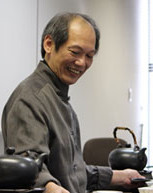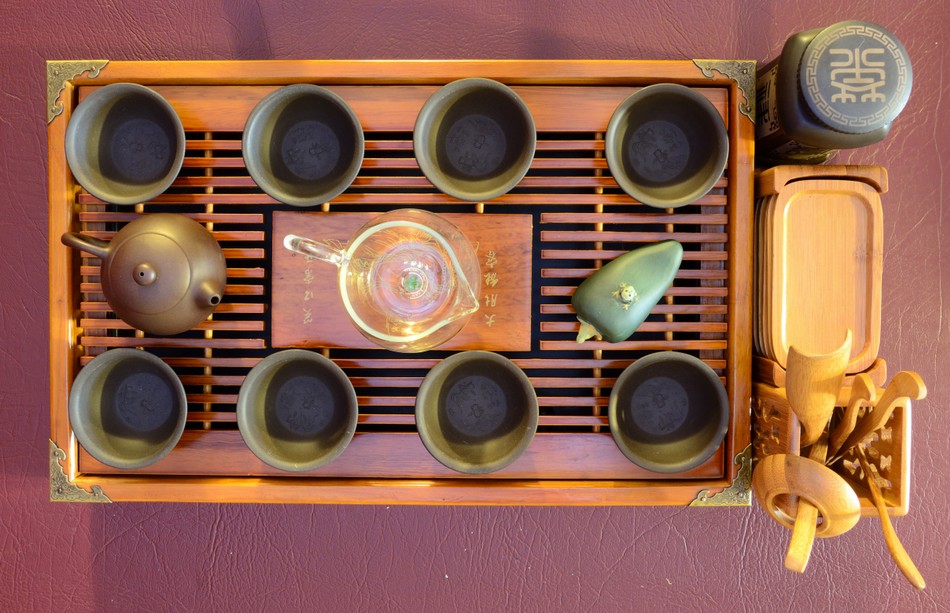Food
We think everyone should have a food page. Food is an international language. Everyone enjoys talking about it and eating it! We hope you do to.
Recipes
We don't use recipes - mostly. However, when someone asks us "how did you make that?" we don't mind writing it down for them, but we don't profess to be good recipe writers. Here are just some of our recipes.
Favourite Foods
Here is a pictorial index to our very favourite dishes. Note: We don't usually take pictures of the food we eat at restaurants, as appreciating the company and cuisine is always more important. Here are just some of our favourite foods we make at home.

French black winter truffles
We buy one every year to remind ourselves that life is a gift and should never be taken for granted.

Tetsuya's Marinated Botan shrimp with sea urchin and Oscietra caviar
Tetsuya's Waku Ghin, Marina Bay Sands, Singapore

Dover Sole a la meunière
Rick Stein's, Winchester, UK

Singapore Chilli Crab with Mantou Buns and Sake
Long Beach, East Coast Seafood Centre, Singapore

Razor Clams
Long Beach, East Coast Seafood Centre, Singapore

Ramen
Tampopo, Liang Court, Singapore

Fois Gras in Marsala sauce
Don Giovanni, Ladprao, Bangkok

Sushi
Sanjugo, Shoreditch, London, UK

Maguro Nigiri
Hajime, South Melbourne, Australia

Duck confit and chips
Pierre Marco-White Steakhouse, Bar and Grill, Windsor, UK

Lobster Lunch
Hursey Seafoood, Stanley, Tasmania, Australia

Lobster and Grange 2004
Richmond Oyster Bar, Oakleigh, Australia
Our Food Journey

Scrambled eggs on toast - with sweet chilli and spring onions
History
We have had a lifetime of being interested in cooking and, of course, eating food. We don't like to follow set recipes, instead we like to re-invent the dishes ourselves, in our own kitchen, using our own processes. When we try a dish that we like, and want to replicate it, we will reverse-engineer everything about it: The look, texture, aroma and taste, using techniques we have learnt or invented ourselves. We watch a lot of TV cooking shows, to pick up new ideas and techniques. We like to first understand the ingredients themselves, often cooking them in several different ways. We like to develop our own cooking techniques; experimenting with them and perfecting our own processes at home in our kitchen. We are infuriated by the way some TV chefs use so many bowls and appliances (we sometimes yell at them on TV!). We get really annoyed when they repeat each-other's "tips and tricks" (for example adding salt to "act as an abrasive" when using a mortar and pestle - Anyone who has done this knows that the salt dissolves immediately and does not help the grinding process at all; but still, they all say it, every time!). It has been a long journey for us and, unfortunately, we don't have a full pictorial record of it. So here are some snapshots including some tips that we have learnt over the years.
Influences
Rick Stein said once that he could tell a good chef simply by the way they scrambled eggs! It definitely requires some care and practice. According to his advice, we lightly mix fresh eggs in a bowl; melt butter (by which we mean healthier, polyunsaturated, margarine, unfortunately) in a pan, on medium heat; pour in the eggs and gently fold the curds into the centre as they form; remove from the heat while they are still partly runny; serve on wholemeal toast with homemade sweet chilli sauce and sliced spring onions.
Our favourite chefs are (in no particular order): Iain Hewitson, Antonio Carluccio, Gennaro Contaldo, Tetsuya Wakuda, Rick Stein, Heston Blumenthal, Jaimie Oliver, Luke Nguyen, David Thompson, Martin Boetz, Kathy Tsaples, Donna Hay. They have taught us so many things about cooking.
Approach
Like journeys around the world, we tend to visit different cuisines and stay for a while to sample their many attractions. We have journeyed through Chinese, Thai, Vietnamese, Japanese, Indian, French, Greek, Italian and other cuisines. We will typically start by eating at a restaurant serving authentic, ethnic cuisine. We savour discuss and reverse-engineer a dish that we have tasted and liked; until we can make it to our satisfaction. It requires some trial and error, but the resulting knowledge, skills and not to mention meals, make it all worth it.
MasterChef Australia
We appeared once on MasterChef Australia, Season 6, Episode 47, at the kind invitation of Don VK3HDX.
On the show, the contestants were divided to pairs and had to serve Asian street food dishes (Chinese, Thai, Vietnamese and Japanese) in a market-style setting. We were part of a group of 200 customers. During the show, Joe was featured speaking with the Green Team (Brent and Tracy), who were serving "Vietnamese Tacos" - delicious pork mince served on round rice-paper roll sheets - grilled not steamed, which was a very clever technique! Joe complemented them on the taste and texture - They were just like crispy, rice-paper rolls, but advised them that they were hard to eat, as the tacos broke when folded, suggesting they should pre-fold them on the flat-top grill.
Tracy thanked him for his feedback and Brent said, in his TV cameo: "One of the customers comes over and he's really pleased with the flavour and he thinks its delicious, but he said it is really messy... I need to take this advice on board and change the idea. So, I'm just going to try a new method and hopefully it is a little bit easier to fold over, for them to eat - so it doesn't fall apart in their face. Trying to adapt to the customer's need - I think it is important. I think if we're to get their vote we need to take everything into consideration."
Honestly, that was a really great response from Brent! Willingness to listen to customers and adapt is the hallmark of a good chef in our opinion.



Wok Hei

We built our own 85MJ/Hr High Pressure (certified) LPG Wok Burner
Because domestic stoves simply cannot achieve what the Chinese call "Wok Hei" - The breath of the wok.

It will deep-fry this whole Tilapia in minutes
Something you just can't do inside on your stove

Crispy Skin Tilapia served with Malaysian sambal and Green Mango
OK, our plating skills will always be shocking. Instead, we focus on technique, taste and texture.
Dough (D'oh)
Our bread and pizza journey has had many dips and turns. Here are some things we have learnt over the years:
- For all bread and pizza dough we have developed our own technique, which is easy and works for us every time.
- The traditional process typically starts by mixing the dry ingredients in the bowl; activating yeast in a separate bowl; adding the activated yeast to the mixing bowl and then adding more water. It ends with a sticky, wet dough, which is then turned onto a floured surface and kneaded for a long time with even more flour to make it firm. Then it is let to rise (twice) and is "punched down" before forming it into shape on a floured surface and letting it rise a final time on a baking tray or tin.
- Well, we hate kneading! It is hard work, takes time and gets flour all over the kitchen bench. We always let the mixer do all the work for us. The traditional kneading process, unless it is very thorough, often traps air pockets and/or unleavend flour in the dough making for an inconsistent "crumb" - the pattern and size of holes inside a loaf.
- We use an old Sunbeam Mixmaster: The one with two dough hooks that look like corkscrews. We have tried the new planetary-motion "kitchenaid" ones, with a single dough hook, and they don't work for us. The dough, unless it is very light, rises up the hook, over the disk, and gets caught in the mechanism.
- We don't wait for the yeast to activate in a separate bowl. It wastes time, a bowl and precious yeast bubbles and, with our way, it makes no difference in the end.
- We shape the dough with oily and not floured hands as it is quicker, washes up easier and leaves the dough with a smooth oily finish to rise. Toppings like sesame or poppy seeds, which can then be added, stick better to the oiled dough.
- We make our bread dough "back to front". Here is our technique:
- First, we pour 500ml of warm water into the mixer bowl, add three teaspoons of dry yeast, one teaspoon of sugar and one tablespoon of oil. All the amounts can be varied to suit the type of dough we are making.
- We start the mixer dough hooks going on the lowest speed and add the flour, spoon by spoon, until there is enough to make a firm dough. Why? The amount of flour you need to add varies, depending on the type and age of flour. The mixer can cope much better starting with a liquid; it will not seize up on flour when you start adding water and you get a smoother dough, with no lumps, much quicker.
- We keep adding flour until the dough has a very firm consistency (poke it and it will resist and bounce back) and let it "knead" in the bowl for 20-30 minutes. (It actually gets quite warm in the bowl, with all the mechanical working, and it rises a bit).
- Then we add two teaspoons of salt (to taste) and "knead" it for another 5 minutes. It makes the dough go all shiny. We add the salt last, because we read somewhere it might kill off the yeast.
- We don't bother with all that rising twice and "knocking" it down process. It wasts time and precious little yeast bubbles.
- We never turn the dough onto a floured surface. We cut the dough to size with a sharp knife as we pour it out of the bowl (in slow motion) onto an oiled baking tray or into an oiled bread tin.
- For pizza, we put some oil on our fingers and spread the dough out to the edges of the pizza tray.
- For rolls, we pick up the dough, with oily hands, roll it into balls or plait it or whatever to shape it.
- We make a crusty bread loaf by putting the dough in an oiled enamelled tin with a tight lid (the high humidity in the covered tin makes it crispy, which is counter-intuitive, but it works)
- We make bagels by first rolling the dough into balls, pinching them in the middle, spinning then around a finger, dropping them into nearly boilling water for 2 minutes a side and then transferring them to a baking tray lined with baking paper.

Tips for making Pizza at home
- Rule #1: Preheat your domestic oven up to the MAX (260 degrees C, if you've got it).
- Rule #2: Less toppings are always more (especially cheese, which just gets everything oily). Try a pizza without cheese or with just a sprinkle of parmesan. They are really great!
- Rule #3: Spread your toppings right to the edge with less in the middle.
- Rule #4: The pizza isn't ready until at least something is burnt crisp on the top.
- Instead of rolling out pizza bases, throw onto an oiled pizza tray and smooth the dough out to the edges of the pan using oiled fingers.
- If you are making production-line pizzas for the hoards in the school staff room (pictured above - not our best work, really), just divide up the ingredients into groups of three and chuck it on.
- Baking pizzas on more than one level in a domestic oven is not ideal: One will be overcooked the other will be under.
- Adjust the distance from the heated base of the oven to get a crispy crust, but not burnt.
- Bogan tip: Allow pizza to cool overnight and eat it in the morning for breakfast! What could be better than pizza for breakfast?
- Reheat breakfast pizza in a covered, non-stick, frypan on very low for 20 minutes (check that it doesn't burn).

Blue Elephant Cooking School, Bangkok
We did both the morning and afternoon course after an early morning visit to the local market. The main thing we learnt about authentic Thai cooking is their use of souring agents like lime and tamarind, always both together. Thai food is too sweet in Australia.



Sous Vide
We made our own sous vide (French for "under vacuum") cooker out of the following components:
- A stainless steel 2400W electric frypan
- A 12VDC pump
- A digital Proportional, Integral, Differential (PID) controller
- A type "K" thermocouple
- A 20A solid-state relay
After filling it with water and running an auto-learning program on the PID controller, it will maintain the water temperature within 1 degree Celsius. The 2400W electric pan heats the water up from cold to 50 degrees C in about 10 minutes.
Sous vide is a great way to prepare diner-party quantities of steak or chicken, cooked to perfection all the way through. It is effectively a confit of meat or fish in oil, herbs and seasoning. We put the ingredients to be cooked into plain zip-lock bags, so no vacuum-sealer is required. We add oil and/or stock to the bag to get good heat transfer. Herbs and seasoning are also added. The bags are cooked in the water for at least an hour, to reach the correct temperature, internally, but they will not overcook at all if left in for three or four hours. Steak requires a quick sear, both sides, on a smoking-hot griddle or heavy base frypan, before serving. Pre-cure salmon and chicken in sugar and salt brine overnight (stops the albumen leaching out while cooking). Pan sear fish skin-side down for 1 minute after cooking.
Typical temperatures are:
- Beef medium rare 57 Celsius
- Beef medium 62 Celsius
- Beef medium well done 67 Celsius
- Beef well done 70 Celsius
- Chicken pink 67 Celsius
- Chicken white 70 Celsius
- Fish 47 Celsius
- Eggs 63 Celsius. For perfectly poached eggs, cook for an hour, then immerse into boiling water for 1 minute.

Home-brew sous-vide cooker

Hainanese chicken cooked on the bone, sous vide.
Topped with ginger and spring onions with master stock and steamed rice.
A Swedish Banquet
Joe and David spent some time in Jönköping, Sweden, testing eTags and tolling gantries for Melbourne City Link. They enjoyed the fresh fish, creamy sauces and lavish deserts.

Fish Roe and Cucumber Salad with Creamy Sauce

Salmon and Vegetables with Creamy Sauce

Icecream with Chocolate sauce
Curry Tree
We bought a spice grinder and went on a journey to India without leaving our kitchen. We developed a "Curry Tree" to help us remember the ingredients for different types of Indian curries. It's a total over-simplification, of course, but it has helped us design our own curries.
From Garam Marsarla at the base (even that varies by region), we branch into (from left to right):
1. Mild coconut milk or yogurt curries.
2. Fragrant curries, Biryanis and Tarka Dahls.
3. Curries with tomato like Rogan Josh.
4. Hot curries like Vindaoo and Madras.

Our "Curry Tree"
An easy way to remember the ingredients for different curries
Paella

Our new Paella pan!
Rick Stein told us to use Spanish Pimenton. We did. He's right.
Chinese Tea Ceremony
We bought a genuine purple-clay tea set from Yixing province in China and some Jasmine Dragon Pearl tea. Joe attended a private Chinese tea ceremony class in Singapore and learnt how to perform it from a master, Mr Lee Chee Keong.

Mr Lee Chee Keong of Liuxiang Tea Craft, Liang Court, Singapore
The Chinese tea ceremony is primarily a celebration of tea and of water, which represents life and purity. The ordinary glass jug symbolises a community spirit as everyone is served from the same vessel. In our opionion, the Chinese tea ceremony is less "theatrical" than the Japanese tea ceremony, as each ceremony emphasises different cultural aspects.

Chinese Tea Set


